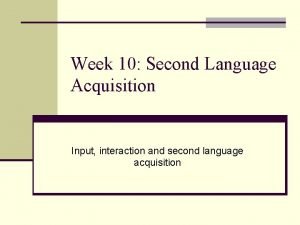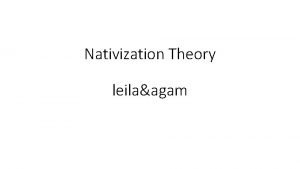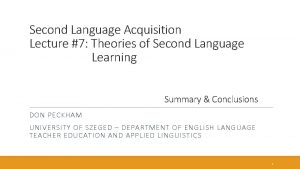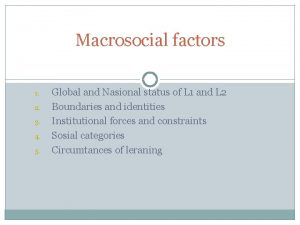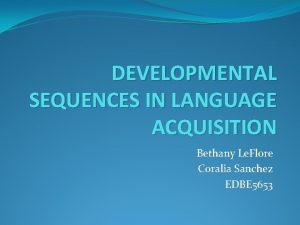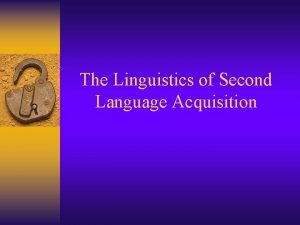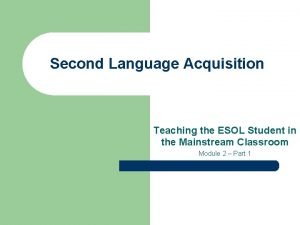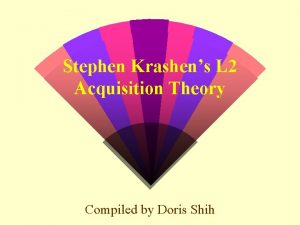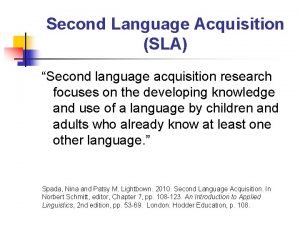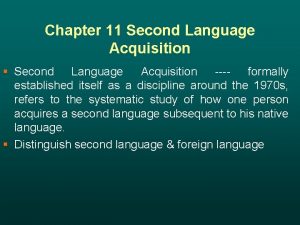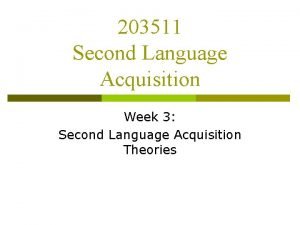Language Acquisition and Second Language Acquisition Crystal Knight











- Slides: 11

Language Acquisition and Second Language Acquisition Crystal Knight S

So what is the Point? S “When applying the concept of language universals to second language acquistion, it is important to remember that theory was originally based on first language acquistion, since children were not formally “taught. ”

What I Believe S That children and adults can learn a new language at any age. The difference is that children will pick up on the language quicker because they are surrounded by other peers who are speaking that language. S The difference for adults when it comes to learning to speak a different language is that it will be more time consuming to learn a language but not impossible.

What do the Experts Say Child Learners S The Critical period hypothesis says that once the LAD ceases to function, and the ability to acquire language with native fluency declines as childhood progresses, disappearing after the age of puberty. Adult Learners S Affective (or emotional) factors S Cognitive factors (the way one processes information) S Metacognitive factors (awareness and understanding of one's own thought processes. ) S Horwitz p. 7

Abstract Grammar Children S S When a child is first learning to speak in their native language the parent should not overly correct the child or imitate the child because this causes frustration. (Rowe & Levine, p. 235) Also children under the age of 12 do not have the necessary cognitive ability to think about grammar abstractly. (Horwitz, p. 18) Adults S For adults learning a second language I believe this to be true as well when adults are learning a second language

L 1 Children S Child: Nobody won’t play with me! S Parent: No, “Nobody will play with me. ” S Child: Nobody won’t play with you, too?

L 2 Children S Child: This broken S Adult: Broken S Child: broken. This /ez/ broken S Adult: Upside down. S Child: upside down, this broken, upside down. broken

Brain Break Did the Adult with the L 1 and L 2 children successfully negotiate the understanding of the conversation? S

Should we correct? The Wug Test (L 1) Conversational Theory (L 2) S The experiment showed that S Yes. Errors should be corrected every child has the ability to extract morphological and phonological rules of their language and apply them to new circumstances. The language of children is productive. in the context of a conversation as the conversational participants negotiate the course of the conversation

Are you seeing the big picture? S

Sources S Horwitz, E. K. (2008). Becoming a language teacher: a practical guide to second language learning and teaching. Boston: Pearson/Allyn and Bacon. S Rowe, B. M. , & Levine, D. P. (2009). Language Acquisition. A concise introduction to linguistics (2 nd ed. , pp. 232 -242). Boston, MA: Pearson/Allyn and Bacon.
 Difference between second language and foreign language
Difference between second language and foreign language Psychomotor considerations language acquisition
Psychomotor considerations language acquisition Input interaction and second language acquisition
Input interaction and second language acquisition What is nativization
What is nativization Language acquisition adalah
Language acquisition adalah 7 theories of second language acquisition
7 theories of second language acquisition Macrosocial
Macrosocial Language learning in early childhood
Language learning in early childhood Second language acquisition questions
Second language acquisition questions Cummins model of second language acquisition
Cummins model of second language acquisition Krashens monitor model
Krashens monitor model Second language acquisition
Second language acquisition


